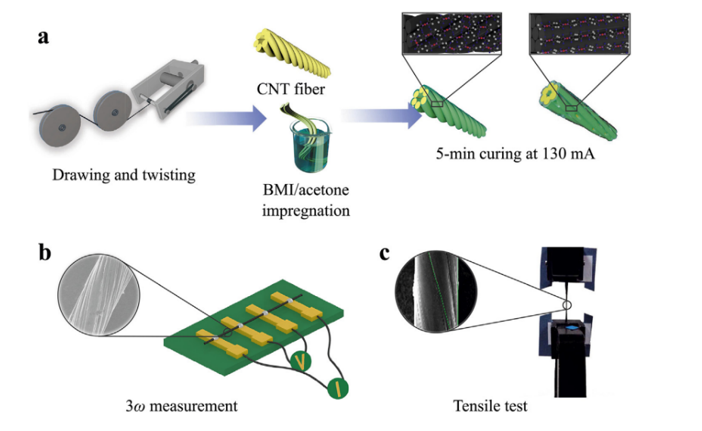Video Article Open Access
Nanoscale Manipulation to Enhance Thermal Transport in CNT Fibers
Lin Qiu1,2
1School of Energy and Environmental Engineering, University of Science and Technology Beijing, Beijing 100083, China
2Beijing Key Laboratory of Energy Saving and Emission Reduction for Metallurgical Industry, University of Science and Technology Beijing, Beijing 100083, China
Vid. Proc. Adv. Mater., Volume 3, Article ID 2206339 (2022)
DOI: 10.5185/vpoam.2022.6339
Publication Date (Web): 19 Mar 2023
Copyright © IAAM
Graphical Abstract

Abstract
Although the individual one- and two-dimensional (1D and 2D) carbon nanostructures possess extremely high thermal conductivity, their macroscopic assemblies do not efficiently utilize it due to the larger interfacial contact thermal resistance. To improve the overall performance, the key is the interfacial structure design to provide sufficient pathways for phonon transport with a limited sacrifice or damage to the inherent thermal properties of nanomaterials. Particularly, the resonance of low frequency lattice vibrations is the most important mechanism for the reduction of the interfacial contact thermal resistance. We focus on how to use various nanoscale manipulation to enhance the inter-tube interfacial thermal transport in CNT fibers, such as strengthening the interaction between CNTs, exciting the resonance of low frequency phonons and introducing crosslinking of polymer chains at the intertube interfaces. Both theoretical and experimental studies show that these manipulation strategies have remarkable boost effect on the interfacial heat transport in CNT fibers. The best thermal conductivity for our manipulated CNT fibers is up to 374 W/m K for a 12 mmlong sample, which is among the top reports.
Keywords
Carbon nanotube fiber; bismaleimide; electro curing; thermal conductivity; thermal radiation.
Acknowledgement
The authors thank financial supports from the National Natural Science Foundation of China (51876008, 51876007, 21503267, 51561145008, U1710122), Youth Innovation Promotion Association of the Chinese Academy of Sciences (2015256), Suzhou Science and Technology Plan Projects (SYG201741), Fundamental Research Funds for the Central Universities from University of Science and Technology Beijing (Lin Qiu), Outstanding Youth Fund of Jiangxi Province (2018ACB21023), and Science and Technology Project of Nanchang (2017-SJSYS-008).
References
- J. Di, X. Zhang, Z. Yong, Y. Zhang, D. Li, R. Li, Q. Li, Adv. Mater, 2016, 28, 10529-10538.
- L. Qiu, X. Wang, D. Tang, X. Zheng, P.M. Norris, D. Wen, J. Zhao, X. Zhang, Q. Li, Carbon, 2016, 105, 248-259.
- F. Yazdandoost, R. Mirzaeifar, Z. Qin, M.J. Buehler, Nanoscale, 2017, 9, 5565-5576.
- W. Yu, J. Fu, L. Chen, P. Zong, J. Yin, D. Shang, Q. Lu, H. Chen, L. Shi, Compos. Sci. Technol, 2016, 125, 90-99.
Biography
Professor Lin Qiu has long been engaged in the research of thermophysical properties evaluation methods of advanced materials, nanocarbon materials for thermal management, and new applications of phase change heat storage. The current research results have published 48 SCI papers, of which 4 were selected as ESI highly cited papers (1%), 2 were selected as ESI hot papers (0.1%), cited more than 1,300 times, h-factor 23, published 2 monographs chapter. 12 authorized national invention patents. Liu Qiu is a director of the Engineering Thermophysics Professional Committee of the Chinese Higher Education Society, a member of the Youth Working Committee of the Beijing Society of Thermophysics and Energy Engineering, a communication review expert of the National Natural Science Foundation of China, and a member of the Academic Committee of the 7th International Conference on Micro-Nano Technology (2019/4/26- 27), Evaluator of Trina Scientific and Technological Achievements Market Transformation Maturity Evaluation System, Editorial Board Member of Applied Thermal Engineering, Scientific Reports, Journal of Thermal Science, Energy Special Issue and Guest Editor of Applied Sciences.
Video Proceedings of Advanced Materials

Upcoming Congress



